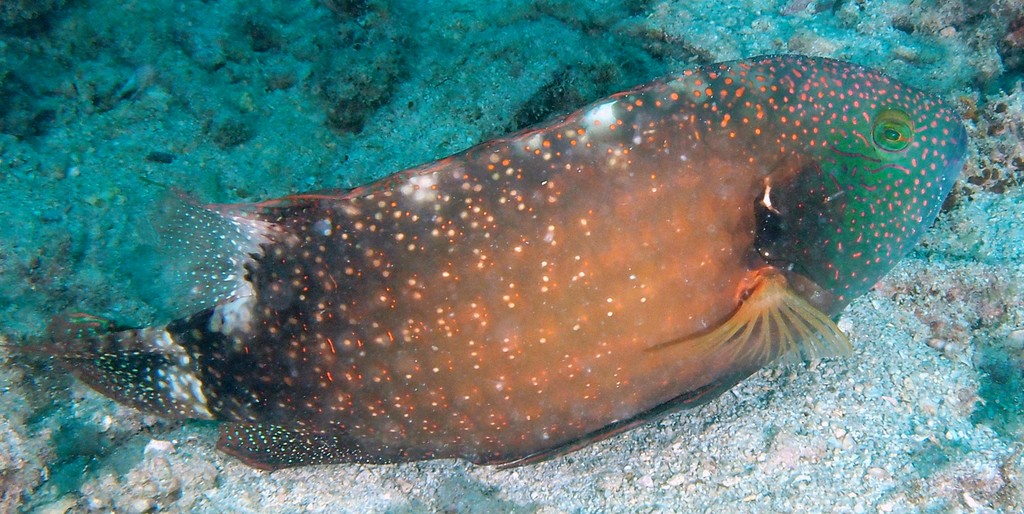CHEILINUS CHLOROURUS - (BLOCH, 1791)
Actinopterygii (Gigaclass) > Actinopteri (Class) > Teleostei (Subclass) > Perciformes (Order) > Labroidei (Suborder) > Labridae (Family) > Cheilinus (Genus)
Vieille tachetée, Madame tombe, Madame tombée, Labre à tache rouge, Labre maori, Dotted maori, Floral maori wrasse, Floral wrasse, White-dotted maori, White-dotted maori wrasse, Yellow-dotted Maori Wrasse, Redspotted maori wrasse, Yellow-spotted Maori-wrasse, Blommetjie-lipvis, Lampa iga-buku tubba, Akaten-mochino-uo, Bodião florido, Vieja florida,
Description
Épines dorsales (Total): 10; Rayons mous dorsaux (Total): 8-9; Épines anales 3; Rayons mous anaux: 8.
Possède 10 épines sur la nageaoire dorsale. Nombresues taches rouges et stries sur la tête. Des taches noires et blanches sur ses nageoires pelviennes, anale et caudale. Taille maximum 45 cm. Zone de profondeur de 2 à 30 m.
Etymologie
Cheilinus : du Grec, chèilos = lèvre.
Distribution
Indo Pacifique : Afrique de l'Est, Australie, îles Ryuku, Indonésie, Nouvelle Calédonie.
Biotope
Zones mixtes (sables, éboulis, coraux) des lagons et des récifs côtiers.
Biologie
ils se nourrissent d'invertébrés benthiques.
Espèces ressemblantes
Cheilinus trilobatus (Lacepède, 1801) - Présent en Nouvelle-Calédonie. Taille maximum 45 cm.
Cheilinus oxycephalus (Bleeker, 1853) - Présent en Nouvelle-Calédonie. Taille maximum 17 cm.
Cheilinus abudjubbe (Rüppell, 1835) - Présent uniquement en Mer Rouge. Taille maximum 25 cm. Espèce remplacée par Cheilinus tribolatus dans le reste de l'Indo-Pacifique de l'Afrique de l'Est à la Polynésie française.
Synonymes
Cheilinus blochii (Valenciennes, 1840)
Cheilinus chlororus (Bloch, 1791)
Cheilinus chlorouros (Bloch, 1791)
Cheilinus chlorurus (Bloch, 1791)
Cheilinus decacanthus (Bleeker, 1851)
Cheilinus guttatus (Bleeker, 1847)
Cheilinus punctatus (Bennett, 1832)
Cheilinus punctulatus (Valenciennes, 1840)
Crenilabrus blochii (Swainson, 1839)
Sparus chlorourus (Bloch, 1791)
Thalliurus chlororus (Bloch, 1791)
Thalliurus chlorurus (Bloch, 1791)
----------------------------------
Description
Dorsal spines (total): 10; Dorsal soft rays (total): 8-9; Anal spines: 3; Anal soft rays: 8. The only Cheilinus that has 10 dorsal spines. Coloration and colours are variable in intensity but always include black and white specks on body and white specks on pelvic, anal and caudal fins. Large adults have numerous red spots and streaks on the head and trilobed caudal fins. Caudal fin of adult males have upper and lower rays prolonged as filaments, conversely, fin rounded in females. Max length : 45.0 cm. Depth range 1 - 30 m.
Etymology
Cheilinus: from Greek, chèilos = lip. Referring to extensible upper lip of Cheilinus trilobatus (Lacepède, 1801).
Distribution
Indo-Pacific: East Africa to the Marquesan and Tuamoto islands, north to the Ryukyu Islands, south to New Caledonia and Rapa.
Biology
Adults inhabit lagoon and coastal reefs, in areas with mixed sand, rubble, and coral. Occasionally in grassy areas. Feed mainly on benthic invertebrates such as mollusks and crustaceans, polychaetes and sea urchin. Oviparous, distinct pairing during breeding.
Similar species
Cheilinus trilobatus (Lacepède, 1801) - Reported from New Caledonia. Max length : 45.0 cm TL. Olivaceous with a vertical red line on each body scale; small red spots and irregular lines on head and chest; red lines radiating anteriorly from eye. Large adults of this species have trilobed caudal fins.
Cheilinus oxycephalus (Bleeker, 1853) - Reported from New Caledonia. Max length : 17.0 cm TL. Brownish red, mottled with small whitish spots; dark brown spot anteriorly on each side of upper lip; 2 dark lines diverging from the eye; dark brown spot on 1st 2 dorsal membranes. Deep-bodied for genus, and snout pointed.
Cheilinus abudjubbe (Rüppell, 1835) - Reported from Red Sea. Max length : 21.8 cm SL.
